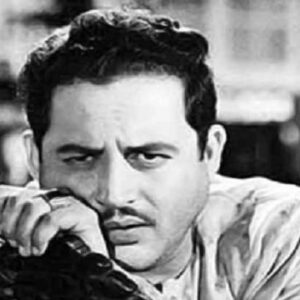Vasanth Kumar Shivashankar Padukone, popularly known as Guru Dutt, was a notable Indian director whose cult classics include ‘Pyaasa’ and ‘Kaagaz Ke Phool’. His films were among the finest ever produced. The fact that he was the first to use close-up shots with 100mm lens cameras in his films, which later became known as “Guru Dutt Shots” in the Indian film industry, demonstrates that his style of filmmaking was quite modern and, at times, ahead of its time. Ironically, his films got notoriety and interest much later, in the 1970s and 1980s, and have gained cult status in recent years. His films covered a broad range of topics, including love, poverty, unemployment, equality, and social values. He was a brilliant artist who excelled in action, production, writing, and even dance, in addition to being a great director. His troubled marriage likely contributed to his untimely demise at the age of 39. Despite his hardships, his inventive use of light and shadow, and his remarkable ability to weave several thematic layers into his narratives, he is regarded as one of the best Indian filmmakers.
Youth and Early Life
He was born in Bangalore, India, on July 9, 1925, to Shivashanker Rao Padukone and Vasanthi Padukone. He had three younger brothers named Atmaram, Devidas, and Vijay, as well as a sister named Lalitha.
His father formerly served as a principal and afterward joined a bank. His mother was a stay-at-home mother who taught private lessons and authored short stories. He spent his early youth in the Bhowanipore neighborhood of Calcutta, where Bengali culture and intelligence shaped his character.
Guru Dutt’s Career
He began his career in Kolkata as a telephone operator for Lever Brothers. In 1944, he quit his work and returned to his parents in Mumbai.
Later, he was engaged as a choreographer by Pune’s Prabhat Film Company on a three-year contract. He then became a member of the company’s acting troupe and also served as an assistant director.
In the 1944 film Chand, he played a tiny role as Sri Krishna. He worked as an actor and assistant director on the film ‘Lakhrani’ the following year. He served as an associate director and choreographer for the 1946 film Hum Ek Hain.
In 1947, his contract with the film firm expired, and he was hired as a freelance assistant by Baburao Pai, the chief executive officer of the Prabhat Film Company and Studio. Soon, though, he became unemployed and began writing short stories for The Illustrated Weekly of India, a weekly English publication published in India.
When Dev Anand invited him to direct the film ‘Baazi’ for Dev Anand’s production business, he reached a turning point in his life. The picture was released in 1951 and was an immediate success.
He went on to direct two additional films, ‘Jaal’ (1952) and ‘Baaz’ (1953), but neither was commercially successful. In 1954, he directed, produced, and acted in the instantaneously successful film Aar Paar.
Later, he directed a number of further films, including ‘Mr. and Mrs. 55’ (1955), ‘Sailaab’ (1956), and ‘Pyaasa’ (1957). Both ‘Mr. and Mrs. 55’ and ‘Pyaasa’, in which he played the lead role, were commercially and critically successful.
In 1959, he produced his most ambitious effort, ‘Kaagaz Ke Phool,’ however it was a box office failure and he lost almost $1.7 million producing the picture.
Later, he acted in two films produced by him: ‘Chaudhvin Ka Chand’ (1960) and ‘Sahib Bibi Aur Ghulam’ (1964). (1962). Both films were commercially and critically a smashing success.
He also acted in films he did not produce, including ’12 O’ Clock’ (1958), ‘Bharosa’ (1963), ‘Bahrani’ (1963), ‘Suhagan’ (1964), and ‘Sanjh Aur Savera’ (1964). (1964).
Guru’s Major Opera
He produced, directed, and acted in the 1957 film Pyaasa, which was an instant hit and is regarded as one of his most renowned works. It is the tale of a poet, rejected by an indifferent world, who finds fame only after his seeming demise.
Another of his favorites, ‘Kaagaz Ke Phool,’ was released in 1959. It was a story about a renowned filmmaker falling in love with an actress. In its day, the film was a box office flop, but by the 1980s, it had become a cult classic.
Awards & Achievements
In 2002, a Sight & Sound critics’ and directors’ poll ranked him #73 on its list of the best directors of all time, making him the eighth-ranked Asian filmmaker in the vote.
CNN ranked him among the top 25 Asian actors of all time in 2010.
Personal History and Legacy
Despite opposition from his family, he married Geeta Dutt, a renowned playback singer, in 1953. They had three children named Tarun, Arun, and Nina. However, the couple had a difficult marriage and eventually divorced due to his workaholic attitude and his romance with actress Waheeda Rehman.
Before his death, he attempted suicide multiple times but was saved by his friends. On October 10, 1964, he died from an overdose of alcohol and sleeping drugs. It is still unknown if he committed suicide or accidentally overdosed.
Estimated Net Worth
Guru is one of the wealthiest and most well-known directors. According to our research, Wikipedia, Forbes, and Business Insider, Guru Dutt has an estimated net worth of $1.5 million.


